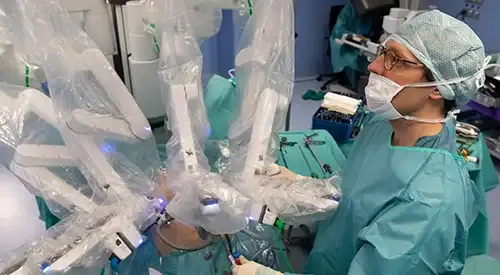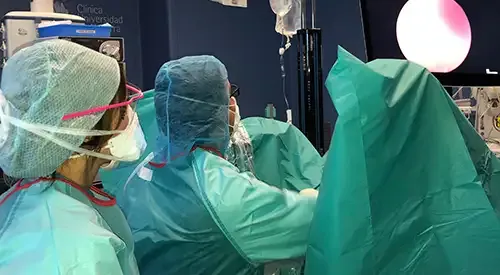Benign prostatic hyperplasia
An accurate diagnosis and follow-up adapted to the characteristics of each patient are of high importance for the achievement of optimal results.
Benign Prostatic Hyperplasia (BPH) is a benign, often progressive disease caused by an increase in the volume of the prostate gland that results in compression of the urethra, causing men who suffer from it to have a number of symptoms that can considerably influence their quality of life.
To obtain a correct diagnosis, it is necessary to estimate the intensity of the symptoms by means of a questionnaire, measure the strength of the urinary stream (flowmetry) and assess both the size of the prostate and the functional situation of the bladder (ultrasound).
With few exceptions, the initial treatment is always pharmacological. In the event that the disease progresses or does not respond to the drugs, it must be surgically resolved.
At the Prostate Centre of the Clínica Universidad de Navarra, we attempt to avoid open surgery as we avail ourselves of our extensive experience in different minimally invasive surgical treatments, appropriate even for those patients who, due to their general condition, are catheterised and cannot be candidates for surgical treatment.
Contact us if you need more information or advice on the checkup you need.

At the Prostate Centre, we apply minimally invasive techniques that reduce the possible complications of open surgery
No other centre in this country has so much experience in the variety of minimally invasive treatments, which makes us a highly reliable option
Photovaporisation with green laser is a technique that we apply to those patients with small or intermediate volume prostates, especially if they are anticoagulated, in which it is not necessary to obtain pathological anatomy.
Our professionals have carried out more than a thousand procedures.
Holmium laser enucleation (HolEP) is the treatment of choice for prostates of greater volume, with the possibility of obtaining a sample for pathological anatomy. A complex technique is carried out through the urethra and is recommended to be carried out in centres with great experience.
Our professionals have carried out more than a thousand operations on prostheses with an average stay of 48 hours.
We use prostatic embolisation in cases where, due to the characteristics or preferences of the patient, it is more appropriate.
It is a technique that, when performed under local anaesthesia, allows us to remove the probe from those patients who are not susceptible to other surgical treatments due to their general condition.
Surgery for benign prostatic hyperplasia, by means of the pure laparoscopic or robot-assisted Da Vinci ® approach, offers us the possibility of treating patients with prostates that, due to their particularly large volume, are not suitable candidates for other transurethral techniques such as holmium laser enucleation.

In addition to the techniques that require high specialization, we carry out other conventional techniques such as bipolar transurethral resection.
It does not leave an incision in the skin and it allows us to treat bladder tumours and lithiasis at the same time as treating benign prostatic hyperplasia.

It is a modern transurethral technique, performed on an outpatient basis and indicated for young patients, who wish to improve the quality of urination without altering ejaculation (a common adverse effect of pharmacological and surgical treatments) and which does not impede future surgical treatments, if necessary.